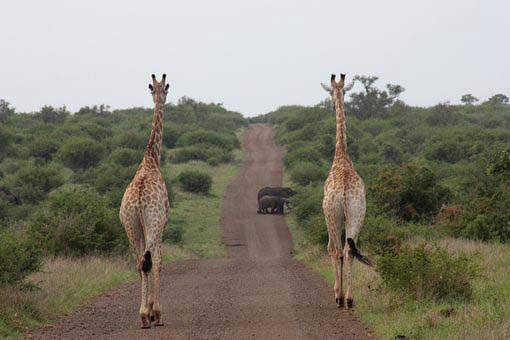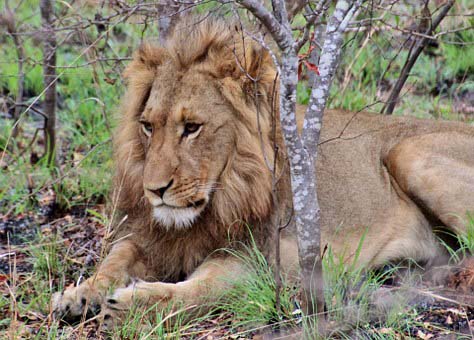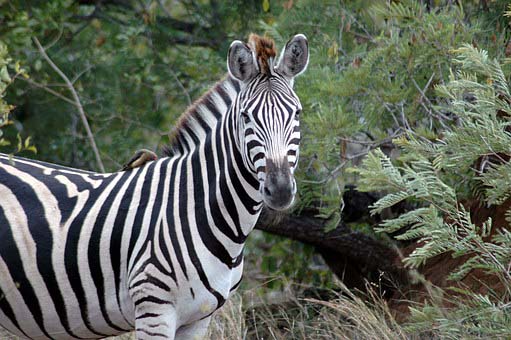Kruger
National Park
Kruger
National Park - A Guide by Stephanie Bayliss
Kruger
National Park Guide
Sabi
Sand Featured Game & Safari Lodges
Kruger
National Park
Location: Mpumalanga,
South Africa
Nearest city:
Nelspruit, South Africa
Area: 18,989
km²
Established:
January 1, 1926
Visitation:
1,336,981 (in 2004)
Governing body:
National Park Service
Kruger National Park is the
largest game reserve in South Africa. It is roughly the same size and shape
as Israel or Wales. It covers about 20,000 square km (7,700 sq mi) and
extends 350 km (217 mi) from north to south and 60 km (37 mi) from east
to west.
To the west and south of
the Kruger National Park are the two South African provinces of Mpumalanga
and Limpopo. In the north is Zimbabwe, and to the east is Mozambique. It
is now part of the Great Limpopo Transfrontier Park, a peace park that
links Kruger National Park with the Gonarezhou National Park in Zimbabwe,
and with the Limpopo National Park in Mozambique.
The park is part of the Kruger
to Canyons Biosphere, an area designated by the United Nations Education
and Scientific Organisation (UNESCO) as an International Man and Biosphere
Reserve (the "Biosphere").

Early history
Evidence of early humans
is found in the area, dating as early as 1,500,000 BC. The San people also
existed in the area as far back as 100,000 BC. In AD 200, the first Nguni
speaking people, looking for more grazing land for their cattle, migrated
south into the area and displaced the San. By 800, the Arabs started raiding
the area for slaves, using the ports in Mozambique. A civilisation also
sprang up in the northern regions of the park. They built the Thulamela
Stone Citadel which was occupied between 1250–1700. They also extracted
iron ore from up to 200 mines, converting it into iron for trade.
The first known European
to explore the area was the Dutch Francois de Cuiper, who led a Dutch East
India Company expedition from the Cape Colony in 1725. However, the expedition
was attacked by local people near Gomondwane, and driven away.
Around 1838, Voortrekker
expeditions led by Louis Trichardt and Hans van Rensburg explored the Lowveld.
In 1845, João Albasini, an 18 year-old Italian, became the first
European to settle in the area. He was stranded in Mozambique and set off
westward, where he built a homestead and opened a trading store near modern
day Pretoriuskop. About the same time, wagon routes were established across
the Lowveld linking the Transvaal Republic to Delagoa Bay (Maputo).
Gold was first discovered
in September 1873 at Pilgrim's Rest, and then in 1881 at Barberton. Fortune
seekers rushed to the lowveld, the prospect of finding gold banished all
fear of lions, crocodiles, and malaria. This started the dramatic decline
of wild animals in the region, due to hunting and trading of animal horns
and skins.

Game reserve
In 1896, the Rinderpest virus
wiped out most of the region's game and cattle. Aiming to preserve game
animals for future hunters, the Transvaal Volksraad voted in favour of
a small government game reserve. Funds for the Sabie Game Reserve were
allocated in 1898, but war broke out. After the Second Boer War, Major
(later Lieutenant-Colonel) James Stevenson-Hamilton was appointed the first
warden in 1902, and a few months later the area from the Sabi river to
the Olifants river was added.
The far north area gained
protection in 1903 as the Singwitsi Game Reserve. This area included Crook's
Corner, a small triangular tongue of land between the Luvuvhu and Limpopo
rivers, where the borders of Mozambique, South Africa and Zimbabwe meet.
In the 1900s this area was a safe-haven for gun runners, poachers, fugitives
and anyone else dodging the law. It was an easy hop across the river whenever
police from one particular country approached. There is a large plaque
here commemorating the legendary ivory hunter Cecil Barnard (Bvekenya),
who hid on an island in the middle of the Limpopo to avoid being tracked
down by pursuing rangers and police in the 1920s. Ironically, Barnard later
became a ranger himself. A police station was later built here.
As a result of nearly a century
of unbridled hunting, there were virtually no animals in the reserves,
and with the reputation of the malarial Lowveld as a white man's grave,
Stevenson-Hamilton removed all human inhabitants from the reserves. In
addition, he and his assistants began shooting all predators in order to
"bring up" the antelope herds.
National Park
In 1912, a railway line was
routed through the reserve. Stevenson-Hamilton successfully used this to
get tourists to stop over for lunch. By 1916 a government commission was
appointed to assess the future of the reserves. In 1926, as an act of reconciliation,
the British administration officially renamed the reserves after Paul Kruger,
and declared it to be South Africa's first National Park. In 1927, the
park was opened to the public who where charged a £1 fee. Only a
handful of cars visited the new park that year, but in 1935 some 26,000
people passed through the gates. Today the number is around one million
per year. Stevenson-Hamilton was surprised when lions became a key attraction,
and he stopped the indiscriminate shooting of the predators. Stevenson-Hamilton
retired in 1946, and he died in 1957.
In the 1960s, in an effort
to boost game numbers, the Water for Wildlife project was started and erected
about 300 windmills in the park. The waterholes attracted game into the
area. At first this seemed a good thing; only decades later did the results
show that with the impalas and zebras the waterholes attracted also brought
more predators into the area. Before the waterholes, these dryer areas
supported roan antelope, which are much easier for lions to catch — the
roans weren't able to compete. The park has started to close the waterholes,
and let nature take its course.

Modernisation
In 1991, Robbie Robinson
became Chief Executive Officer (CEO) of the South African National Parks
Board. Robinson began the transition of the park into the new South Africa.
One of his many accomplishments was removing the fencing that separated
the park's western border from numerous small, private game reserves, thus
allowing the animals to roam freely between the private game reserves and
Kruger National Park.
In 1998, the Kruger National
Park's first black director was elected. David Mabunda is now CEO of the
South African National Parks Board.
With the forming of the Great
Limpopo Transfrontier Park, large, unsustainable herds of animals in the
Kruger National Park can now be translocated to near-virgin bush. The war
ravaged 300 km² Limpopo National Park in Mozambique (formerly known
as Coutada 16) started receiving animals in 2001.
On October 21, 2002, the
Kruger Mpumalanga International Airport was opened near Nelspruit, some
63 km from the closest park gate. The airport is intended to increase accessibility
to the park from major South African centres, namely Durban, Cape Town
and Johannesburg. Despite the name, the airport does not handle notable
volumes of international traffic at this stage. Indeed, the airport is
not especially commercial; with only South African Airlink and two other
small operators running commercial flights.

Flora and fauna
Plants
The Kruger National Park
is divided into six eco-systems: Baobab sandveld, Mopane scrub, Lebombo
knobthorn-marula bushveld, mixed acacia thicket, Combretum-silver clusterleaf
woodland on granite and riverine forest. Altogether it has 1,982 species
of plants.
Birds
Out of the 517 species of
birds found at Kruger, 253 are residents, 117 non-breeding migrants, and
147 nomads.
Mammals
All the Big Five game animals
are found at Kruger National Park, which protects over 147 species of mammals.
As of 2004, the park has counted approximately:
-
25,150 African Buffalo
-
200 African Hunting Dogs
-
350 Black Rhinoceros
-
32,000 Burchell's Zebras
-
500 Bushbucks
-
200 Cheetahs
-
300 Common Eland
-
9,000 Giraffes
-
5,000 Greater Kudus
-
3,000 Hippopotamus
-
over 170,000 Impalas.
-
1,000 Leopards
-
2,000 Lions
-
160 Mountain Reedbucks
-
300 Nyalas
-
300 Reedbucks
-
60 Roan Antelopes
-
550 Sable Antelopes
-
11,670 Savannah Elephants
-
2,000 Spotted Hyenas
-
200 Tsessebes
-
3,800 Warthogs
-
5,000 Waterbucks
-
5,000 White Rhinoceros
-
17,000 Blue Wildebeest
The park stopped culling elephants
in 1989 and tried translocating them, but by 2004 the population had increased
to 11,670 elephants. The park's habitats can only sustain about 8,000 elephants.
The park successfully started using annual contraception in 1995.
The Kruger National Park
holds over 48 tons of ivory in storage. According to Convention on the
International Trade in Endangered Species of Wild Flora and Fauna (CITES),
it is allowed to sell 30 tons.
Reptiles, fish, and amphibians
There are 120 species of
reptile, including approximately 5,001 Nile Crocodiles, 52 species of fish,
and 35 species of amphibians.
Accommodation
The Kruger National Park
has 21 rest camps, as well as 7 private lodge concessions, and 11 designated
private safari lodges. The concessions are parcels of land operated by
private companies in partnership with communities, who outsource the operation
of private lodges.
Rest camps
-
Balule: Situated on the southern
bank of the Olifants River
-
Bateleur
-
Berg-en-Dal: This modern camp
opened in February 24, 1984 is situated on the bank of the Matjulu Spruit
in the south of the park. It is the only camp set in a rugged mountain
environment and is built on the site of a prehistoric settlement.
-
Biyamiti Bushveld camp
-
Crocodile Bridge: Built in the
1930s on the bank of the Crocodile River in the south-eastern corner of
the park.
-
Letaba: Situated on the banks
of the Letaba River.
-
Lower Sabie: Situated on the
bank of a dam in the Sabie River.
-
Malelane: One of the smallest
rest camps.
-
Maroela: A small camp overlooking
the Timbavati River.
-
Mopani: Built in 1989 on the
eastern bank of the Pioneer Dam.
-
Olifants: Set on a cliff overlooking
the Olifants River.
-
Orpen
-
Pretoriuskop: Built on the wagon
route from Lydenburg goldfields to the coast and named after Willem Pretorius
son of Andries Pretorius. It is situated in the western-most, highest,
coolest and wettest part of the park.
-
Punda Maria: Built in 1919 as
a ranger outpost this northern-most camp's name is thought to have originated
from a misspelling of the Swahili word punda millia, meaning zebra and
the area's first section ranger JJ Coetzer's wife Maria. It was converted
into a rest camp in 1933.
-
Satara: In the 19th century,
before the park was declared, this area of the lowveld was carved up settlement
by burghers of the Transvaal Republic. One of the surveyors was an Indian
who marked the present-day Satara area on his map with the Hindi word satra,
meaning 17.
-
Sirheni: A small camp situated
in a riverine forest on the edge of Sirheni dam which is fed by the Mphongolo
River.
-
Shimuwini Bushveld Camp
-
Shingwedzi: Alluvial gold was
discovered here.
-
Skukuza: This is the main camp
in the Kruger National Park, it is situated on the southern bank of the
Sabie River and can sleep 1,000 visitors in rondavels, bungalows, river-fronting
units and group cottages. It even has a 9 hole golf course. When founded
in 1902 it was originally named Sabie Bridge, but was changed in 1936 to
Stevenson-Hamilton's Shangaan name, Skukuza which can be translated as
"he who sweeps clean" or "he who turns everything upside down".
-
Talamati
-
Tamboti Tented Camp: A small
tented camp set in a forest on a loop of the Timbavati river.
Wilderness trails
The seven walking trails
offer 3 nights of bush solitude in areas of wilderness virtually untouched
by humans. There are no set trails in the wilderness areas; you walk along
paths made by animals or seek out new routes through the bush.
-
Bushman: Near Berg-en-Dal.
-
Metsi-Metsi: Near Orpen Dam
and N'wamuriwa Mountain.
-
Napi: Between Skukuza and Pretoriuskop.
-
Nyalaland: North of Punda Maria,
near Luvuvhu River.
-
Olifants: Near Olifants camp,
on the Olifants River.
-
Sweni: Near N'wanetsi.
-
Wolhuter: Between Berg-en-Dal
and Pretoriuskop.
Independent lodges
-
Boulders Bush Lodge
-
Roodewal Bush Lodge
-
The Outpost Lodge: Situated
at Crook's Corner.
Private lodge concessions
-
Imbali: 100 km² of concession
with: Imbali Safari Lodge: On the banks of the Nwatswitswonto River and
Hoyo Hoyo Tsonga Lodge: Set up as a traditional Tsonga village on the banks
of the Mluwati River.
-
Hamilton's Tented Camp
-
Jock Safari Lodge: Was the first
private lodge set in park and the Mantis Shamwari group holds this 60 km²
concession between Pretoriuskop and Lower Sabie. It has 12 suites at the
lodge.
-
Lukimbi: Situated on the Lwakahle
River in a 150 km² concession in the southern part of the park near
Malelane.
-
Mutale
-
Ngala Tented Safari Camp: Lies
on 147 km² concession.
-
Rhino Walking Safaris: It is
the only privately run wilderness trail concession in the park with the
exclusive rights to 120 km². It also includes: Rhino Post Safari Lodge:
A 5 star lodge.
-
Singita Lebombo Lodge: This
150 km² concession is looked after by the Singita Group of Lodges.
This lodge lies on the southern edge of the Nwanetsi River, east of Satara
near the Lebombo Mountains on the park's eastern boundary.
-
Tinga: 50 km² of concession
with two lodges: Narina Lodge and Legends Lodge
|



